Released on Aug. 16 of this year, the nVidia GeForce GTX 660 Ti is one of the higher-end offerings based on the new Kepler architecture. With its specs and intended performance, the card looks to capture the market of those looking for a card that can really drive even the most demanding of modern games. To see how the card performs in real testing, we selected one of our machines that was running an AMD Radeon 6870 to see how the two stack up. For those looking to upgrade from a capable card, does the GeForce GTX 660 Ti offer that much more?
To answer the question, we set up and documented our hardware and testing methods. The PC used is a relatively modern build, composed of the following configuration:
| Hardware | |
|---|---|
| Processor | Intel i5 2500k @ 3.3GHz |
| Memory | 8gb Patriot Gamer 2 (DDR3 1600) |
| Motherboard | ASUS Sabertooth P67 (Rev. 3.0) |
| Hard Drive | OCZ Summit 60 GB SSD |
| Operating System | Windows 7 x64, Service Pack 1 |
| Graphics Cards | nVidia GeForce GTX 660 Ti 2Gb (GeForce 306.23 Driver) AMD Radeon 6870 1Gb (Catalyst Version 12.8) |
To put that platform through its paces, the games and tools used to generate the data were:
| Games/Tools Used | |
|---|---|
| 3dMark Vantage | Built-in Benchmark |
| Unigine | Built-in Benchmark |
| Batman: Arkham City | Built-in Benchmark |
| Sleeping Dogs | Built-in Benchmark |
The physical card design is a fairly simplistic one, with most of the card encased in rectangular black plastic complete with an industrial-looking design. A single ventilation fan provides airflow, and "GeForce GTX" appears in green lettering along the spine. Like most modern cards, it covers two plates and provides one DVI-I port, one DVI-D port, one HDMI port and one DisplayPort. Two PCI-E power connectors are needed to power the card, with the ports conveniently mounted on the spine. The physical dimensions of the card are about the same as what you would expect and should fit in most standard cases, and the rather boxy design and easy-access power ports makes installation painless even in more cramped cases.
To kick off the testing, we ran each card through a series of tests in 3dMark Vantage. The first test was set up to run through both GPU tests using the "High" preset, with the only change being that the resolution was set to 1920x1080 (as it is for all ensuing tests). This amounted to 2x anti-aliasing, 8x anisotropic filtering, and a setting of "High" for all of the quality dropdowns.
The second test was set up to go through the same tests using the "Extreme" preset, similarly with the resolution changed. This bumped up the anti-aliasing to 4x, the anisotropic filtering to 16x, and a setting of "Extreme" for all quality dropdowns.
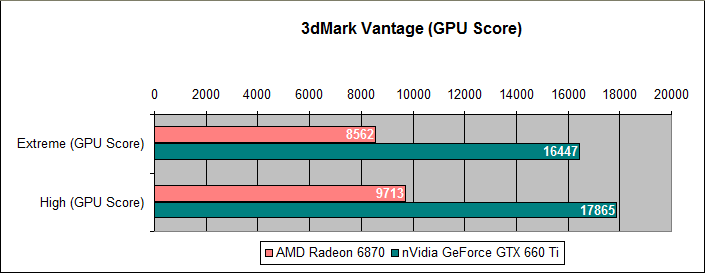
Right out of the gate, the GTX 660 Ti comes out incredibly strong and rates at nearly double the GPU score that the Radeon 6870 was capable of achieving.
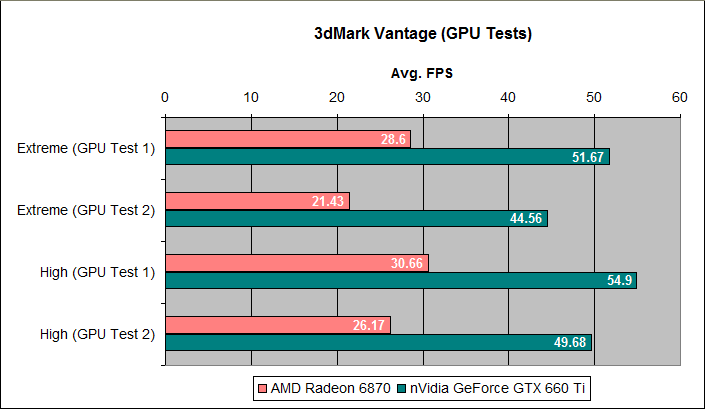
Breaking down the results of the individual GPU tests during each set of testing shows similar results across the board. Regardless of the settings used, the GTX 660 Ti is capable of just about double the performance in 3dMark Vantage's testing.
To continue with the more synthetic testing, the next tool used was Unigine's Heaven benchmarking tool. Unigine Heaven is capable of putting stress on even the highest-end setups, and once again, there were two test runs used against each card. The first run used "stock" settings. The list includes no anti-aliasing used, 4x anisotropic filtering, and everything enabled except for tessellation, which was disabled.
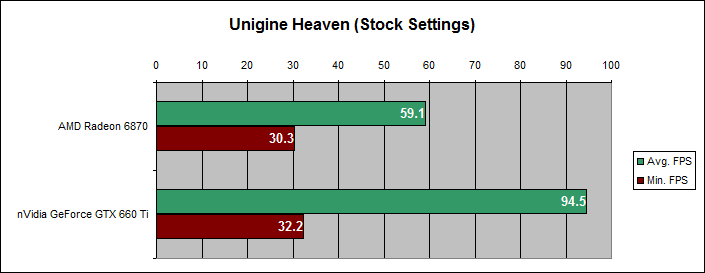
Both cards performed fairly well in this test, with strong average frame rates and certainly respectable minimums. The margin that the GTX 660 Ti had in the previous tests isn't quite as strong here but still significant. Oddly, the two cards had a similar minimum frame rate, which was consistent through multiple runs.
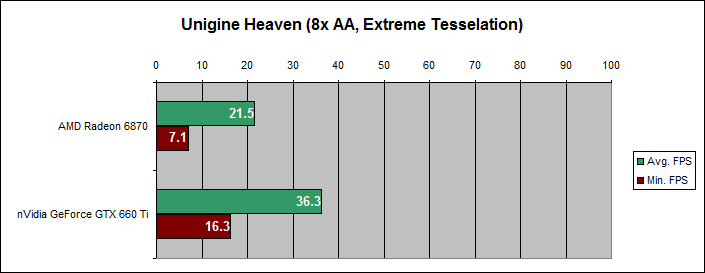
For the second test, the settings were amped up a bit, with the anti-aliasing and anisotropic filtering cranked up to 8x and tessellation set to "extreme." Both cards showed considerably lower average frame rates, but once again, the margin of the GTX 660 Ti over the Radeon 6870 is relatively the same.
To get into some actual game-centric testing, we first fired up Batman: Arkham City. Most modern cards have little issue running the game at or near the highest settings, making the tests more of a horse race than ones of sheer might. Three tests were run; one at the "Very High" graphics preset, one at the "Extreme" preset, and a third that used the "Extreme" preset as a base only with 8x MSAA instead of FSAA.
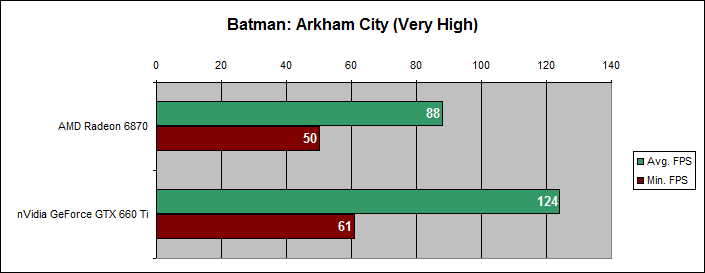
It is unsurprising that both cards have absolutely no trouble at this setting, and at this point also unsurprising that the margins between the two cards remain the same.

In this second test, the cards still perform well, albeit with much lower minimum frame rates measured during testing. Both cards reached the same minimums in the same spot in the tests, seeming to point to some bottleneck other than the performance of the cards.
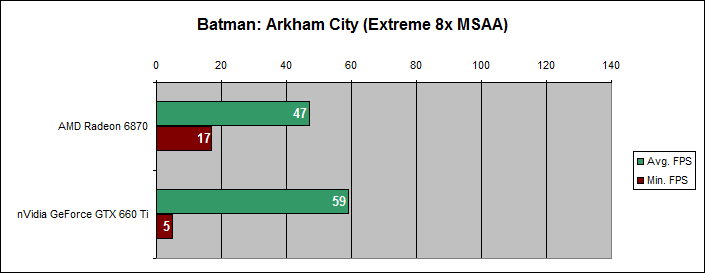
In the third test, the rift between the two cards becomes surprisingly narrow. Though a minimum frame rate of a mere five was measured, it was hard to discern where it occurred, leading one to suspect there's another issue at play other than the cards. Once again, both cards ended up performing quite well, with the GTX 660 Ti delivering just a modestly smoother experience.
To round out our testing, we selected Sleeping Dogs, as its higher graphics settings are certainly capable of making older cards such as the Radeon 6870 sweat. The first test was set up using the "High" preset while the second uses the "Extreme" preset, with the main differences between the two being that of the level of "quality anti-aliasing" used.
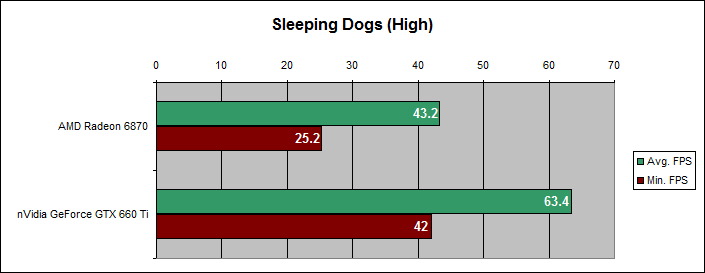
Though the game is certainly playable on the "High" setting on the Radeon 6870, the GTX 660 Ti dominates the test to the point that its minimum frame rate is the former card's average.
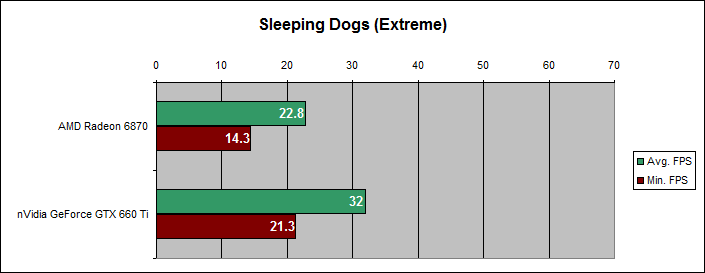
In the final test between the two cards, both sweat more than a little bit under the "Extreme" preset. Once again, the GTX 660 Ti's minimum frame rate almost beats out the Radeon 6870's average, and visually between the two, the Radeon didn't seem to keep up with the test nearly as well as the smoother example set by the GTX 660 Ti.
In some of the synthetic testing, the two cards seemed to be worlds apart, with the GTX 660 Ti nearly showing double the frame rates or scores of the Radeon 6870. However, this margin was a bit more realistic in the gaming benchmarks and a margin that consistently hovered around 40 to 50 percent. Both visually and data-wise, the GTX 660 Ti outpaced the other card. This is to be expected given that the Radeon is two years older than the brand-new GTX 660 Ti, but it's still an impressive improvement.
At the same time, when the Radeon 6870 was released in 2010, it was $239 and can currently be found for $169. While the GTX 660 Ti is nearly double the price, in our testing, it was able to deliver much higher frame rates at lower graphics settings and was able to get playable frame rates at maximum settings at times when the Radeon 6870 could not.
Where does that leave those who are looking to pick up a new video card right now? If you have a video card that is older than a couple of years or are without a video card at all, the nVidia GeForce 660 Ti is an absolute no-brainer. For a single card, it is able to achieve smooth frame rates in even some of the most demanding tests that we ran against it, and it will likely continue to do so for some time. Though its price point ranks up there at what most people consider a maximum for their upgrade budget, the nVidia GeForce 660 Ti delivers a level of performance that certainly justifies it.
Score: 9.4/10
More articles about nVidia GeForce GTX 660 Ti











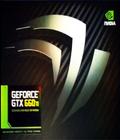 The GeForce GTX 660 Ti delivers geometry performance for the ultimate next-generation DX11 gaming experience. With full support for NVIDIA 3D Vision, the GeForce GTX 660 Ti provides the graphics horsepower and video bandwidth needed to experience games and high definition Blu-ray
movies in stereoscopic 3D.
The GeForce GTX 660 Ti delivers geometry performance for the ultimate next-generation DX11 gaming experience. With full support for NVIDIA 3D Vision, the GeForce GTX 660 Ti provides the graphics horsepower and video bandwidth needed to experience games and high definition Blu-ray
movies in stereoscopic 3D.


